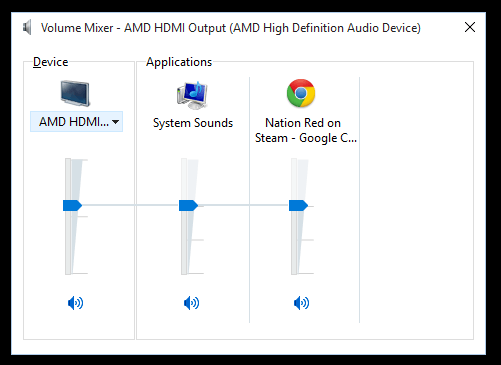46
12
Googling for solutions to this problem seems to lead to third party solutions like this, sometimes with scripting like this. I'm no stranger to either, but It seems crazy to me that there isn't a better solution.
I'm on Windows 10. I use HDMI audio to my monitor from my AMD video card, and I use a set of headphones plugged into the back of my motherboard. I use both often, but right now I need to tediously switch the default playback device to switch between them (sometimes, for reasons I don't yet know how to replicate, I even need to fully disable the device currently making sounds.
This is what I see in the volume mixer after starting my computer up with AMD HDMI as the default, and opening Chrome to watch a video:
When I switch to the Speakers device
I see that it is not assigned any applications, and I see no way to reassign applications:
I can usually hammer all of the applications over to the Speakers device by switching the default playback device, and usually vice versa. But that sometimes that only switches some applications, and sometimes it doesn't do anything. But that's besides the point...
How can I assign an application to a specific audio playback device? The Volume Mixer looks like the right place, but it doesn't seem to do it unless I'm missing something.



2Like many others, I'm coming from Google. I'd just like to make an additional question: Why on earth would Windows recognize per-application audio output and yet does not allow us to change? It would be far better just not provide this feature at all and let us pick a single device for all output. It's so frustrating. – Henrique Jung – 2017-11-20T21:31:22.697
@HenriqueJung basically because is not a windows task to do so. What you change in windows is actually default audio device but application can select any audio device it likes. Some apps can handle this change and switch device when user switches default device but many may not. It's quit easier for OS to change volume of the app than force it to switch audio context. In many cases it may be even not posible. For ex. how to handle DTS sound on devices that dose not support it etc. That why windows left decision on which sound device should be played music to an application. – Logman – 2018-05-31T13:04:10.007
I wish this question wasn't closed without a single answer mentioning that Windows 10 does let you configure output, and input, audio per application. I also wonder why the hell Google always send me the duplicate instead of the original answer (well, observation bias -- I don't know there are duplicates when I'm sent to the original, but it still bothers me!). – Daniel C. Sobral – 2018-09-10T16:59:02.523